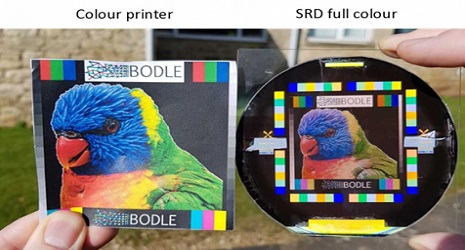Electronic displays that need (almost) no power
A case study by C David Wrighta and Harish Bhaskaranb
aUniversity of Exeter, bBodle Technologies Ltd.

Full colour image of a Rainbow Lorikeet written into Bodle’s SRD® phase-change display technology (© Bodle Technologies Ltd.) [1].
The problem
Current display technologies are inherently volatile – they need a constant power source to display images. This is a particular drawback for battery-powered devices, where the screen is often the major consumer of system power. Conventional displays are also difficult to read in bright sunlight - in such conditions the only solution is to turn up the screen brightness and use even more power.
Our solution
In collaboration with Bodle Technologies Ltd. (www.bodletechnologies.com) we are developing an entirely new approach to displays technology, one that uses a combination of so-called phase-change materials (e.g. the alloy GeSbTe) and metamaterials concepts to deliver entirely non-volatile, full colour displays [1, 2]. Here, colour is generated by an optical nano-cavity formed by embedding ultra-thin layers of GeSbTe (or other phase-change alloys) in a resonant structure or metasurface. Switching the phase-change alloy between its amorphous and crystalline states, which we can do electrically, changes the colour generated, enabling us to create a vivid palette of colours. The colours remain once power is removed, so power is only required when an image changes (which in many applications, such as mobile phones, is not very often!). Moreover, the more light that shines on the display, the brighter the image becomes – a very useful feature (as those of us who have tried to read our mobile phones in the bright sunshine will know!).
Potential applications are not just limited to mobile phone type displays however. We can also imagine the technology being used for smart signage, wearable displays, advertising, and much more.
Why use a metamaterial?
To generate the basic colours from which we can make a full colour palette (i.e. red, green and blue for additive colour generation; cyan, magenta and yellow for subtractive colour generation), we need to be able to control quite precisely the region of the spectrum over which our new display devices absorb and/or reflect light. The use of resonant cavities and/or optical metasufaces (the 2D version of metamaterials) allows us to do just this. And combining the cavities/metasurfaces with phase-change materials gives us direct electrical control of the colour generated.

Smart signage application of phase-change metasurface type display [2]
References
[1] Hosseini P, Wright CD, Bhaskaran H. (2014) An optoelectronic framework enabled by low-dimensional phase-change films, Nature, volume 511, no. 7508, pages 206-211
[2] Carrillo SG-C, Trimby L, Au Y-Y, Nagareddy VK, Rodriguez-Hernandez G, Hosseini P, Ríos C, Bhaskaran H, Wright CD. (2019) A Nonvolatile Phase-Change Metamaterial Color Display, Advanced Optical Materials, DOI:10.1002/adom.201801782.
